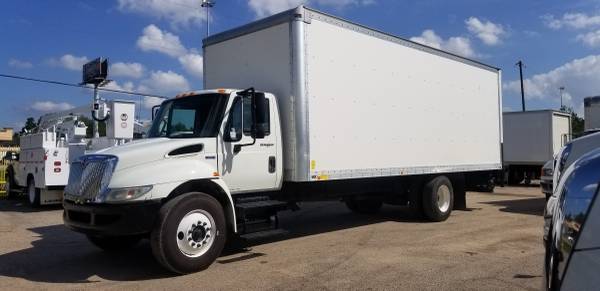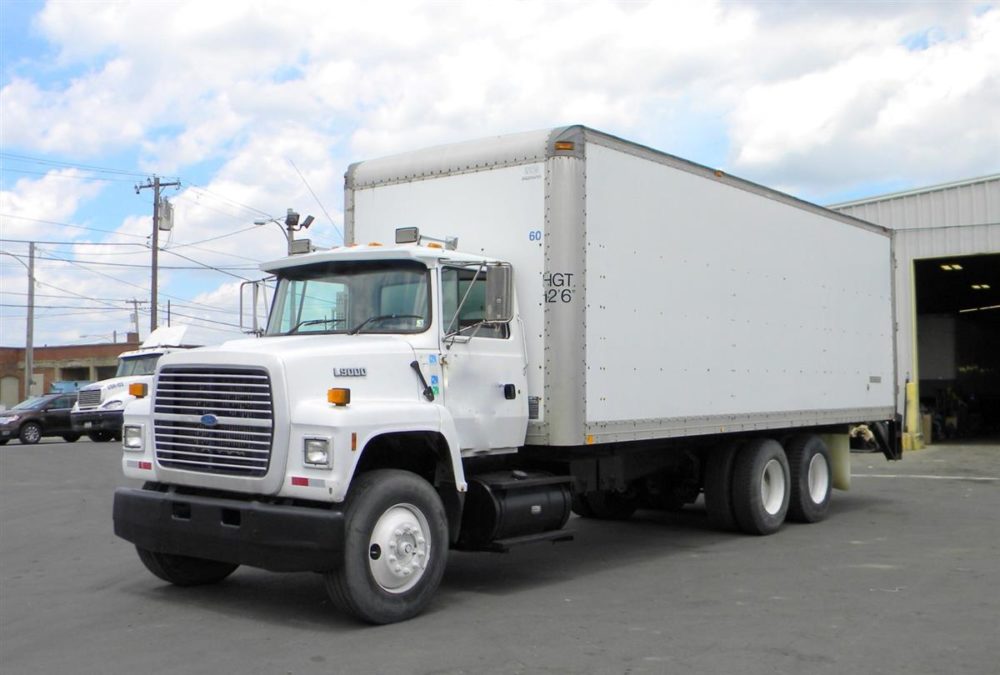26-foot box trucks are great, multi-use vehicles. Their medium size makes them manageable to more casual drivers, while they’re spacious enough to carry large quantities of cargo. The trucks work great for moving; you can fit many furniture and personal possessions into the vehicles.

Contents
A 26-foot-long truck, capable of holding up to eight rooms worth of furniture, inevitably intensely tips the scales. There are rules and regulations for the weights of trucks, so it is worth knowing: just how much does a 26-foot box truck weigh?
An empty 26-foot box truck weighs 16,000 pounds, while one, filled to capacity, weighs 26,000 pounds.
Several considerations weigh into a truck’s mass; this article examines the dimensions and capacities of the 26-foot box truck while discussing the many variables that contribute to truck weights.
How Big Is a 26-Foot Box Truck?
26-foot box trucks fall right in the middle of the truck-size spectrum. As the name suggests, the vehicle is 26 feet long, with a 1,682 cubic foot volume capacity. The total dimensions of this kind of box truck are 26 feet long by 102 inches (eight and a half feet) wide by 102 inches high. The vehicle seats three passengers and can hold up to 10,000 pounds of cargo.
1,682 cubic feet and 10,000-pound capacities are a bit abstract, so more tangibly, that hard data translates to:
- 12 pallets
- 500 medium-sized boxes
- Roughly eight rooms of furniture
With space for eight rooms worth of furniture, it’s unsurprising that these vehicles are the moving trucks of choice for many. They’re also great for parcel and perishable food delivery. Some adventurous cooks have even turned 26-foot box trucks into mobile restaurants.
How Heavy Is a 26-Foot Box Truck?
The 26-foot box truck is, expectedly, a heavy piece of machinery. The precise weight varies depending on whether the truck is empty or loaded. Empty, the vehicle weighs 16,000 pounds, but it can hold 10,000 pounds of cargo. The maximum weight of the truck, filled, is 26,000 pounds or 13 tons. That figure is called Gross Vehicle Weight or GVW, one of several terms applied to trucks and their weights.
Truck Weight Terminologies
Trucks have multiple measurements to take into account-the vehicle loaded, empty, and the maximum amount of weight the truck can hold. Each of these measures has a specific notation and definition. Let’s examine some essential pieces of truck vocabulary:
- GVWR (Gross Vehicular Weight Rating): This represents the maximum possible weight of a truck. The measurement totals the truck’s unloaded weight with the full volume it can carry.
- Curb weight: Your truck’s curb weight is however much it weighs empty, except for a full tank of gas and fully equipped. The added mass of passengers, cargo, or any alterations does not factor into curb weight.
- Payload capacity: Payload capacity is the amount your truck can carry, including passengers. Mathematically, the payload capacity equals gross vehicle weight minus curb weight.
- Cargo Weight: Cargo weight is the measure of everything placed in the truck, including passengers.
Understanding how your truck’s weight is measured is essential because there are laws pertaining to the maximum weight a truck can carry. While there is some variation to these rules from state to state, generally, the top weight measures are:
- Gross weight: 80,000 pounds
- Gross weight on a single axle: 20,000 pounds
- Gross weight on tandem axles: 34,000 pounds
Different Models of 26-Foot Box Trucks
While most brands and varieties of 26-foot box trucks have the same dimensions, there are some variations. The chart below compares some of the critical components of popular brands.
| Brand | Internal Height | Outside Dimensions | Height Clearance | Weight (in pounds) | GVWR | Key Features |
| Hino | 103 inches | 26’X102”X156” | 13’6” | 15,000 | 26,000 | VNT Turbochargers, 5 year warranty |
| Penske | 92 inches | 26’X7’8”X8’1” | 12’7” | 16,000 | 26,000 | Automatic transmission, Air conditioning, towing compatible |
| Freightliner | 97 inches | 26’X97”X91” | 14’-16’ | 16,820 | 26,000 | Low step in height, tinted windshield |
What Class Is a 26-Foot Box Truck?
There are nine classes of trucks, the first three all indicative of smaller vehicles. The 26-foot box truck is a class four. The chart below explains the weight breakdown of classes four through nine.
| Class | Weight in pounds |
| 4 | 14,000-16,000 |
| 5 | 16,001-19,500 |
| 6 | 19,501-26,000 |
| 7 | 26,001-33,000 |
| 8 | Over 33,001 |
| 9 | Over 60,000 |

Commercial truck weight limits vary from state to state. Mostly the maximum heft is 80,000 pounds. However, the maximum gross weight applicable to a single axle and double axle differs more. The chart below lists the values dictated by each state:
| State | Single Axle | Double Axle | Gross Weight |
| Alabama | 20,000 lb | 34,000 lb | 80,000 lb |
| Alaska | 20,000 lb | 38,000 lb | 80,000 lb |
| Arizona | 20,000 lb | 34,000 lb | 80,000 lb |
| Arkansas | 20,000 lb | 34,000 lb | 80,000 lb |
| California | 20,000 lb | 34,000 lb | 80,000 lb |
| Colorado | 20,000 lb | 36,000 lb | 80,000 lb |
| Connecticut | 22,000 lb | 36,000 lb | 80,000 lb |
| Delaware | 20,000 lb | 34,000 lb | 80,000 lb |
| District of Columbia | 21,000 lb | 37,000 lb | 79,000 lb |
| Florida | 20,000 lb | 40,000 lb | 80,000 lb |
| Georgia | 20,340 lb | 34,000 lb | 80,000 lb |
| Hawaii | 22,500 lb | 34,000 lb | 80,000 lb |
| Idaho | 20,000 lb | 34,000 lb | 80,000 lb |
| Illinois | 20,000 lb | 34,000 lb | 80,000 lb |
| Indiana | 20,000 lb | 34,000 lb | 80,000 lb |
| Iowa | 20,000 lb | 35,000 lb | 80,000 lb |
| Kansas | 20,000 lb | 34,000 lb | 80,000 lb |
| Kentucky | 20,000 lb | 34,000 lb | 80,000 lb |
| Louisiana | 20,000 lb | 34,000 lb | 80,000 lb |
| Maine | 20,000 lb | 34,000 lb | 80,000 lb |
| Maryland | 20,000 lb | 34,000 lb | 80,000 lb |
| Massachusetts | 18,000 lb | 34,000 lb | 80,000 lb |
| Michigan | 20,000 lb | 34,000 lb | 80,000 lb |
| Minnesota | 10,000 lb | 34,000 lb | 80,000 lb |
| Mississippi | 20,000 lb | 34,000 lb | 80,000 lb |
| Missouri | 20,000 lb | 34,000 lb | 80,000 lb |
| Montana | 20,000 lb | 34,000 lb | 80,000 lb |
| Nebraska | 20,000 lb | 34,000 lb | 80,000 lb |
| Nevada | 20,000 lb | 34,000 lb | 80,000 lb |
| New Hampshire | 20,000 lb | 34,000 lb | 80,000 lb |
| New Jersey | 20,000 lb | 34,000 lb | 80,000 lb |
| New Mexico | 21,600 lb | 34,200 lb | 80,000 lb |
| New York | 20,000 lb | 34,000 lb | 80,000 lb |
| North Carolina | 20,000 lb | 38,000 lb | 80,000 lb |
| North Dakota | 20,000 lb | 17,000 lb | 80,000 lb |
| Ohio | 20,000 lb | 34,000 lb | 80,000 lb |
| Oklahoma | 20,000 lb | 34,000 lb | 80,000 lb |
| Oregon | 20,000 lb | 34,000 lb | 80,000 lb |
| Pennsylvania | 20,000 lb | 34,000 lb | 80,000 lb |
| Rhode Island | 22,400 lb | 36,000 lb | 80,000 lb |
| South Carolina | 10,000 lb | 35,200 lb | 80,000 lb |
| South Dakota | 20,000 lb | 34,000 lb | 80,000 lb |
| Tennessee | 20,000 lb | 34,000 lb | 80,000 lb |
| Texas | 20,000 lb | 34,000 lb | 80,000 lb |
| Utah | 20,000 lb | 34,000 lb | 80,000 lb |
| Vermont | 20,000 lb | 34,000 lb | 80,000 lb |
| Virginia | 20,000 lb | 34,000 lb | 80,000 lb |
| Washington | 20,000 lb | ———- | 80,000 lb |
| West Virginia | 20,000 lb | 34,000 lb | 80,000 lb |
| Wisconsin | 20,000 lb | 34,000 lb | 80,000 lb |
| Wyoming | 20,000 lb | 34,000 lb | 80,000 lb |
Do Box Trucks Have to Stop at Weigh Stations?
The answer varies from state to state. Each region has its own weigh station rules. Weigh stations exist to ensure your truck’s GVWR does not exceed prescribed guidelines. Some states, like Alabama and Connecticut, don’t require trucks to stop at weigh stations. On the flip side, California requires every truck to weigh in.
Many states, like Georgia and Indiana, require trucks with GVWs exceeding 10,000 pounds to stop at a weigh station. Wyoming picks trucks at random for weigh station inspections, and Florida requires trucks transporting agricultural products to stop.
Is It Hard to Drive a 26-Foot Box Truck?
Anyone with a driver’s license can operate a 26-foot-box truck. Commercial Driver’s Licenses, or CDLs, are only required for trucks with a GVWR of over 26,000 pounds. The GVWR of a 26-foot box truck is 26,000, so the vehicles squeak under the wire.
There is a learning curve to driving a box truck. Generally speaking, you should be wary of the following:
- Speed
- Turns
- Clearance
Box trucks require spacial awareness; the most significant difference you will feel driving one versus a regular car simply compensates for the additional bulk and greater size. Driving a 26-foot box truck isn’t difficult for anyone who can drive a car but should be eased into and approached with care. Drive slowly and allow ample room for turns.
FAQs
Here are the most frequently asked questions regarding 26-foot box trucks and their weight management.
How do you know how much a truck can carry?
You can determine your truck’s payload capacity by subtracting its curb weight from its GVWR.
What is the difference between curb weight vs. gross weight?
A truck’s curb weight is its heft when empty. The curb weight is included in the gross weight; the gross weight is the summation of the weight of the truck plus the maximum weight your vehicle can carry.
What is the difference between dry weight vs. cargo weight?
Dry weight is the measure of your vehicle without any additives; no liquids, including fuel or coolant, and no cargo. Cargo weight is every additional pound added to the curb weight, including passengers and whatever you may be hauling.
Do small box trucks have to stop at weigh stations?
Weight station rules vary from state to state. Pennsylvania requires all trucks to stop, but most states only mandate trucks weighing 10,000 pounds and up to go through weigh stations.
What is the gas mileage of a 26-foot box truck?
26-foot box trucks generally get eight to ten miles per gallon of diesel gas. The vehicles’ fuel tanks have a sixty-gallon capacity, so trucks travel 600 miles on a full tank.
How much does a 26-foot box truck cost?
The cost of a 26-foot box truck depends on the seller and whether you are buying one new or used one. Factors impacting the cost of the truck include:
- Seller
- Truck brand
- Truck condition
Considering these variables, a 26-foot box truck ranges between 26,000 and 60,000 dollars.




